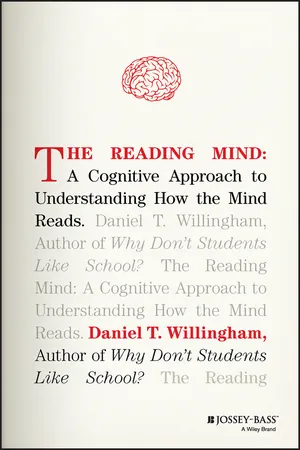
The Reading Mind
A Cognitive Approach to Understanding How the Mind Reads
- English
- ePUB (mobile friendly)
- Available on iOS & Android
About this book
A Map to the Magic of Reading
Stop for a moment and wonder: what's happening in your brain right now—as you read this paragraph? How much do you know about the innumerable and amazing connections that your mind is making as you, in a flash, make sense of this request? Why does it matter?
The Reading Mind is a brilliant, beautifully crafted, and accessible exploration of arguably life's most important skill: reading. Daniel T. Willingham, the bestselling author of Why Don't Students Like School?, offers a perspective that is rooted in contemporary cognitive research. He deftly describes the incredibly complex and nearly instantaneous series of events that occur from the moment a child sees a single letter to the time they finish reading. The Reading Mind explains the fascinating journey from seeing letters, then words, sentences, and so on, with the author highlighting each step along the way. This resource covers every aspect of reading, starting with two fundamental processes: reading by sight and reading by sound. It also addresses reading comprehension at all levels, from reading for understanding at early levels to inferring deeper meaning from texts and novels in high school. The author also considers the undeniable connection between reading and writing, as well as the important role of motivation as it relates to reading. Finally, as a cutting-edge researcher, Willingham tackles the intersection of our rapidly changing technology and its effects on learning to read and reading.
Every teacher, reading specialist, literacy coach, and school administrator will find this book invaluable. Understanding the fascinating science behind the magic of reading is essential for every educator. Indeed, every "reader" will be captivated by the dynamic but invisible workings of their own minds.
Frequently asked questions
- Essential is ideal for learners and professionals who enjoy exploring a wide range of subjects. Access the Essential Library with 800,000+ trusted titles and best-sellers across business, personal growth, and the humanities. Includes unlimited reading time and Standard Read Aloud voice.
- Complete: Perfect for advanced learners and researchers needing full, unrestricted access. Unlock 1.4M+ books across hundreds of subjects, including academic and specialized titles. The Complete Plan also includes advanced features like Premium Read Aloud and Research Assistant.
Please note we cannot support devices running on iOS 13 and Android 7 or earlier. Learn more about using the app.
Information
1
On Your Marks
Agenda for Chapter 1
| Observation | Arithmetic expression | Principle |
| The order of purchases doesn't affect the total | A + B + C = A + C + B = B + A + C, etc. | Commutativity |
| If you buy something, and then return it, you end up the same amount of money you started with | X – Y + Y = X | Negative numbers |
| If you pay for items individually or all at once, the cost is the same | (A) + (B) + (C) = (A + B + C) | Associativity |
How Writing Might Work
Table of contents
- Cover
- Title Page
- Copyright
- Dedication
- Table of Contents
- List of Tables and Figures
- About the Author
- Acknowledgment
- Introduction: The Chicken Milanese Problem
- 1 On Your Marks
- 2 Sound It Out
- 3 Reading at a Glance
- 4 Words, Words, Words
- 5 Reading Comprehension
- 6 Becoming a Reader
- 7 Reading After the Digital Revolution
- Conclusion
- Works Cited
- Index
- Notes
- End User License Agreement